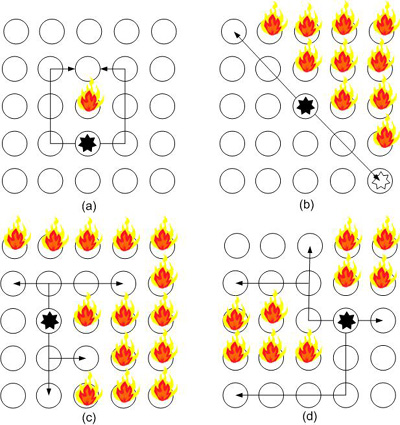
This is an example of how a single Agilla agent can be used to detect and form a perimeter around a fire. Fire is modeled by an agent that OUTs a tuple containing the string "fir" into the local tuplespace, and then continuously blinks the red LED. A fire tracking agent is then injected into the network that forms a perimeter around the fire. The fire tracking agent initially wanders around the network looking for fire. Each time it arrives at a node, it checks whether any neighbors are on fire. If so, it clones itself onto nodes within two horizontal and vertical gridhops of the fire. This process is repeated by the clones, eventually forming a perimeter. Fire detection agents continuously check the fire and proactively adopt to breaches in the perimeter.
There are two types of fire agents: static and dynamic. Static agents do not spread, they stay where they are initially injected. Dynamic agents gradually spread, eventually engulfing the entire network.
The source code for the agents are here:
To test the efficiency of the fire detection agents, two experiments are run. All of our experiments are run on a 5x5 wireless sensor network of MICA2 motes. The first set of experiments measures how quickly a tracker agent can form a perimeter around a static fire of various shapes. We consider four scenarios, they are shown below:

Videos of these experiments are given below. Windows Media player is required to play the videos.
The second set of experiments tests how well the tracker agents can proactively adjust the perimeter as the fire spreads. Four tracking agents are initially injected into the network, then the dynamic fire agent is injected. The nodes on which these agents are injected are shown below:

Note that the tracker agents are injected into four regions of the network. This is to maximize the liklihood that they will quickly detect the fire. This experiment is run twice with two different fire-spreading rates: fast and slow.